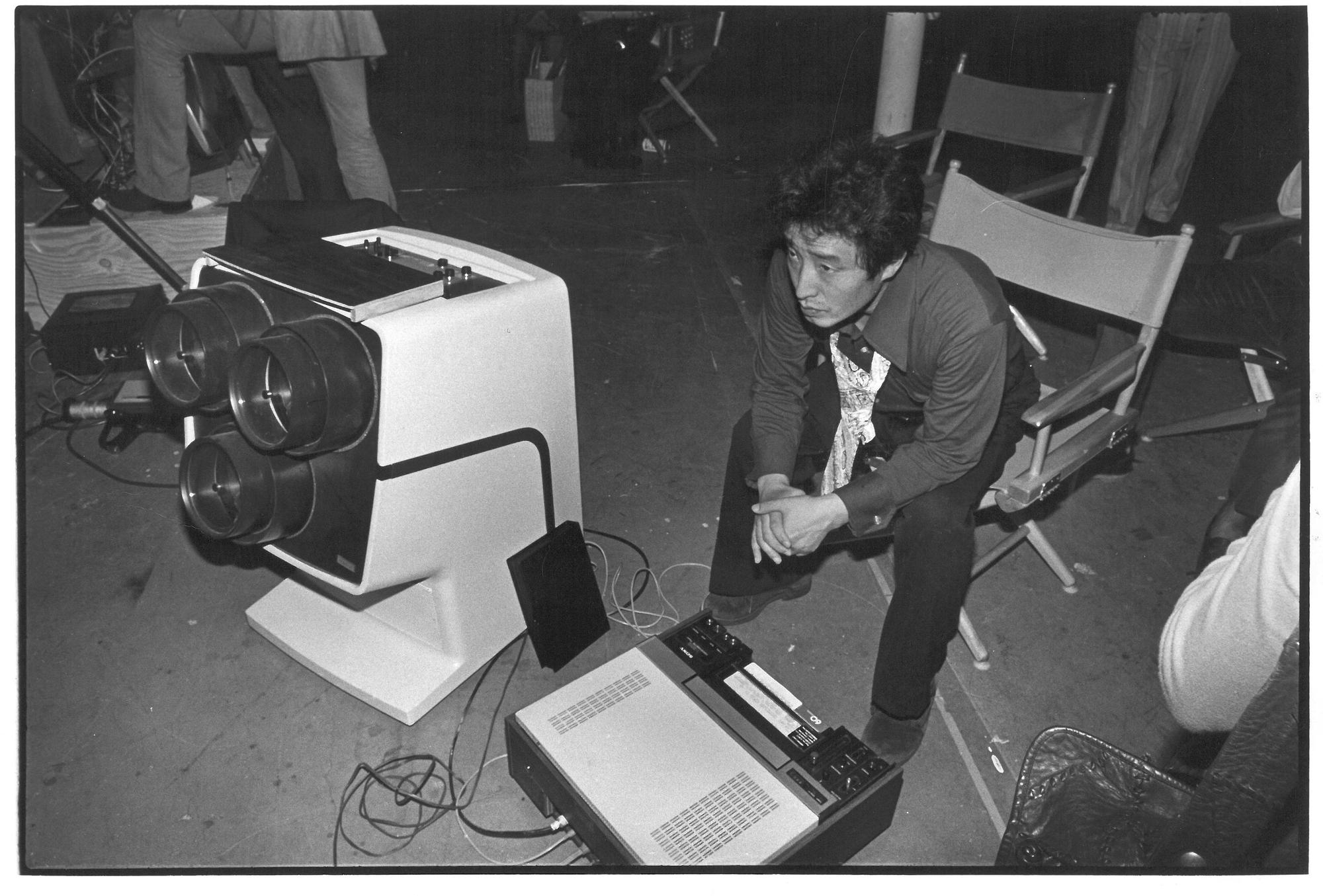Nam June Paik was a video artist and the founder of video art. To video artists such as Paik, television and mainstream media was the enemy, as underground cultures who developed and practiced video art were mainly interested in mass culture and aesthetic experimentation. They were mainly self-funded, had low budgets and did not receive Arts grants by the government until later on as video art wasn’t recognised as a legitimate medium.

Nam June Paik pictured with his equipment at the MIT Center for Advanced Visual Studies.
This idea of DIY aesthetic bled into other mediums such as music video, as video art began to hit commercial avenues. Early examples of this can be seen in the first ever broadcast commercial for MTV in 1981 where the advertisement features layered digital images and has a distinctly unique graphic quality and visual composition which lends itself to the aesthetic of video art culture.
Abstract shapes and vivid colours were just some of the many features that video art experimented with, as electronic media during the late 1980’s to early 1990’s was at the forefront of technology.
These was a real sense of hands on craftsmanship that came with the trial and error of producing this digital medium, as poor quality, unstable tape was converted into stable, playable videos. Limited by the technologies of the time, video artists would often play around with different types of cameras, media, lighting and editing to create functional pieces of art.
Horsfield explained in the reading that it was only in 1995 that the “first digital camcorders were marketed” (2006, p. 8), meaning that prior to this, video artists would have little access to digital technology and editing software. If they did work with this equipment however, it would be very costly and most likely come out of pocket for the artist. Thus in the beginning, only a limited number of people could afford to practice video art on a large scale. With the introduction of newer, cheaper and more readily available advanced technologies, “independent producers could finally make broadcast quality tapes on low-cost consumer equipment” (Horsfield 2006, p. 8).

Nam June Paik, ‘Global Groove’ video still, 1973.
When viewing the earliest tapes of video art, I was immediately reminded of an artist collective called AWGE. Standing for A$AP Worldwide Global Enterprise, AWGE is a highly secretive creative agency founded by rapper A$AP Rocky and backed by his hip-hop collective A$AP Mob. Featuring a gang of video artists, producers, curators and like minded people, AWGE is transcending into music video, fashion, music and countless mediums, all utilising video art conventions and aesthetic.

The most notable works of AWGE are their music videos and directorial debuts in songs such as Yamborghini High by A$AP Mob, “The Mattress” by A$AP Ferg, Magnolia by Playboi Carti and many others, amassing hundreds of millions of views on platforms such as Youtube. The music video that arguably popularised AWGE and their video editing was that of Plain Jane by A$AP Ferg.

The Awge logo, taken from a still of one of their music videos.
Who is the practitioner (what is their name?) and when were they practicing?
The musician is rapper A$AP Ferg and the director of his music video for the song ‘Plain Jane’ is AWGE, more specifically videographers Hidjifilms, Ricky Dula, ygaflm etc.
With the photo or video you are examining when was it produced (date)?
The music video was released on the 11th of October 2017.
How was the photo or video authored?
The video was made using a variety of recording equipment. In ‘The Making Of A$AP Ferg’s “Plain Jane” Video With AWGE | Framework’ video posted to Genius’ Youtube channel, AWGE director Hidjifilms discusses the various cameras and techniques used to create the distortion, layering and cut and paste video art elements of the music video. Camcorders, iphones, and other recording devices were used by the various videographers working on the project, which gives different angles and effects to the same scene. He states in the breakdown of one particular scene that “It doesn’t matter what you record on, its how you edit it”.
The director also stated that artist George Condo (who created the album artwork for Kanye West’s My Beautiful Dark Twisted Fantasy) was a major inspiration in the editing and final aesthetic of the music video, as throughout the video, the editors incorporated stills which cut and layer various photos to create intricate and mismatched collage-like imagery which is a signature style of AWGE.
How was the photo or video published?
The music video was published to A$AP Ferg’s Youtube channel and can be found on AWGE’s website where they showcase their works and other collaborations.
In terms of the integrity of the video quality when uploading to a site such as Youtube, due to its gritty, grainy, experimental, low-fi quality, the aesthetic of ‘Plain Jane’ is mostly benefited, as any quality lost during the uploading process would contribute to the overall perception of the video.
How was the photo or video distributed?
Amassing over 33 million views on the Youtube video alone, ‘Plain Jane’ became the anthem of Ferg’s ‘Still Striving’ album and AWGE’s influence skyrocketed after the music videos release. As Youtube is an open platform to viewers across the globe, the ability to like, comment and share the music video further accelerated its popularity and spread the aesthetic of AWGE across multiple platforms, where the music video was advertised.
References:
Horsfield, K 2006, Busting the Tube: A Brief History of Video Art. Video Data Bank, School of Art Institute of Chicago, pp. 1–9.
https://www.awgeshit.com/#home
https://vimeo.com/116094187